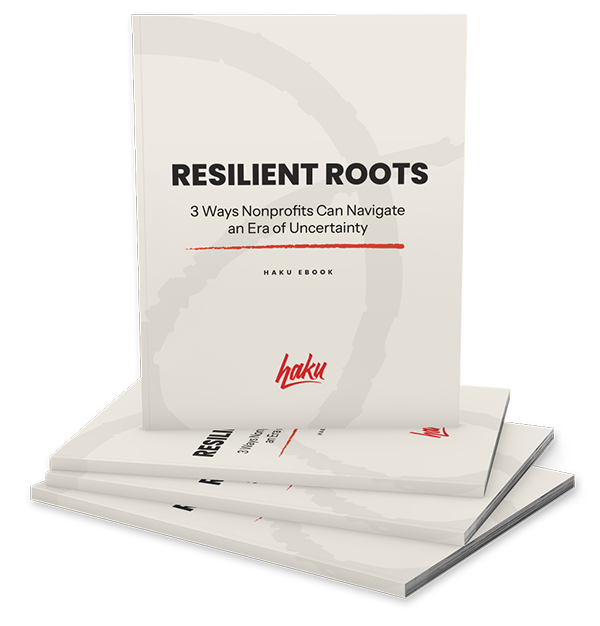Articles
How Nonprofits Can Build Resilience in the Face of Funding Challenges
Nonprofits are facing rising costs, fragile funding, and widening data gaps in 2025. This blog shares findings from our recent eBook and explores why resilience is the key to turning today’s uncertainty into sustainable growth.

Practical ways to adapt and thrive in an era of uncertainty
Nonprofit resilience is the ability to absorb funding shocks, maintain operations, and adapt in uncertain environments.
Like trees caught in a storm, nonprofits in 2025 are being tested by powerful shifts in the financial landscape. Rising operating costs, uncertain government funding, and the pressure to do more with fewer resources are shaking even the strongest organizations.
For nonprofits, the roots keeping you stable are your relationships with supporters, your ties to community, and the systems that keep your mission steady. Resilience is what allows you to absorb revenue shocks without breaking and to keep growing even when the fundraising environment is harsh.
In our new ebook, Resilient Roots: 3 Ways Nonprofits Can Navigate an Era of Uncertainty, we explore how organizations can strengthen those foundations. This blog will walk through some of the pressures we explore in the ebook and provide much needed context for why 2025 has presented so many unique challenges.
Uncertainty and Funding Shocks in 2025

In 2025 the need for nonprofits to operate more efficiently and secure their revenue streams has increased sharply. With a striking 81% of organizations reporting higher operating costs, averaging out at a 15% increase, it’s clear that a strong financial grounding is required to thrive going forward. This economic situation means every dollar needs stretching further amongst staffing needs, event logistics, and technology, your organization is probably looking into how to keep costs under control.
The natural instinct in times like these is to cut back. Trim expenses. Delay projects. Freeze hiring. But true resilience comes from finding ways to absorb funding shocks without losing momentum on your mission. That means looking into alternative funding sources when grant monies are cut, or if giving amounts decrease.
Diversifying your revenue streams is a key step to building this financial resilience, because it allows you to grow out from your financial anchors, those revenue sources that underpin your regular fundraising efforts.
For example, if you have annual or quarterly galas, those events may offer a unique opportunity to incorporate a digital auction alongside the in-person event. If you rely on direct giving, there may be new opportunities to encourage DIY fundraising.
Even e-commerce has moved beyond being a niche funding source for nonprofits. Branded merchandise and limited-edition campaigns can work hand in hand with events, direct giving campaigns, and other fundraising to create recurring micro-streams that smooth cash flow between major initiatives.
There are several causes for this funding uncertainty, but one that has emerged more than ever in 2025 has been the unreliability of government funding.
Why Government Funding is Unreliable for Nonprofits in 2025
Grants have long played a central role in the nonprofit landscape. 67% of U.S. nonprofits receive some form of government funding, and for organizations in health and human services the connection is even stronger. Grants in particular are a major source of funding for many organizations. Unfortunately, what was once a reasonably reliable resource has become far more fraught recently
In particular, certain federal policies have introduced new challenges. Some organizations are facing delayed disbursements of grant monies that have already been approved and others are trying to balance new requirements which include aligning with political messaging not related to their actual mission.
For groups that depend on those dollars, these challenges can mean scrambling to cover payroll, pausing community programs, or dipping into reserves. Even when delays are short term, funding shocks can disrupt major events or giving campaigns, cause issues with technology access, and more.
Even if your nonprofit doesn’t rely directly on HHS or other federal grants, the ripple effects of these disruptions matter. When health organizations lose or delay funding, the burden often shifts downstream to local nonprofits, community partners, and service networks. Then, increasingly fatigued private donors have to pick up the slack. Competition for this limited pool of dollars intensifies as well, leaving everyone more vulnerable to disruption.
The answer to these challenges is not necessarily to abandon government funding entirely but rather ensuring your mission isn’t left hanging when those dollars falter. That might mean expanding charity-partner event participation, encouraging grassroots DIY fundraising, or cultivating corporate sponsorships that operate outside federal budgets.
We’ve discussed why nonprofits are facing funding shocks, but external factors aren’t the only ones to blame for this uncertainty.
Data Gaps Represent a Vulnerability

Funding sources aren’t the only keys to a resilient organization. Nonprofits need to have clarity to protect their mission and grow the revenue they already have available. Yet, many nonprofits still operate with major gaps in their supporter and campaign data.
In 2024, only 52% of nonprofits conducted any form of audience research. That means nearly half are making mission-critical decisions without knowing which strategies resonate most with their stakeholders, which supporters are most engaged, or which campaigns truly drive return.
It isn’t only supporter and audience research that is often lacking for nonprofit organizations. Siloed data and difficulty gaining a 360 degree view of your stakeholders causes problems as well. If you don’t know which initiatives deliver the best results, you can’t allocate resources wisely. Similarly, if you lack insight into your supporters’ motivations and behaviors, you can’t deliver experiences that deepen connection.
When experiences fall short, it’s far harder to keep donors and volunteers involved over the long term. The result is wasted energy, underperforming campaigns, and avoidable attrition. While this is the status quo for many organizations, there is a real opportunity for nonprofits to build more resiliency by bridging those gaps.
To become a resilient organization you must treat clarity as essential. With better visibility, staff can make fast, confident choices. In turn, this lets them amplify what works, fix what doesn’t, and build lasting loyalty with supporters. To do this, you should consider developing a supporter feedback process if you don’t have one already.
Lay Resilient Roots for Your Nonprofit
2025 has been a year of challenges for nonprofits. With rising costs, fragile government funding, and persistent data gaps the pressure can feel overwhelming even for well established organizations. But resilience isn’t about solving every problem at once. It’s about building habits and systems that let your organization adapt no matter where the pressure comes from.
In our recent ebook, Resilient Roots: 3 Ways Nonprofits Can Navigate an Era of Uncertainty, we highlight three strategies that nonprofits can use to strengthen that adaptability:
Diversify revenue streams. Relying on a single source of funding leaves organizations exposed. By expanding into auctions, eCommerce, peer-to-peer, or DIY campaigns, nonprofits create multiple inflows that reduce risk and stabilize revenue.
Steward the supporter journey. Donors and volunteers aren’t just transactions. They’re long-term partners. Organizations that invest in recognition, community, and transparency create loyalty that keeps people engaged through uncertain times.
De-risk through data and technology. Disconnected systems slow decision-making and obscure results. Integrated tools reveal the true ROI of campaigns and give staff the clarity to invest where impact is greatest.
Resilient organizations prepare for disruptions rather than wait for them. By weaving these strategies into everyday practice, nonprofits turn pressure into momentum and uncertainty into confidence.
Lay Resilient Roots for Nonprofit Success

Nonprofits can’t control the economic winds, the fragility of federal funding, or the shifting behavior and expectations of supporters. But what you can control is how you prepare your organization to face uncertainty.
Rising costs, disrupted grants, and data gaps will continue to test the strength of every mission in 2025 and increasing your resilience is how you stay steady in that storm. It’s about creating financial anchors that hold you firm, cultivating relationships that deepen loyalty, and building systems that give you clarity when conditions change. These strategies ground your organization while keeping you connected to the community you serve.
Our recent ebook, Resilient Roots: 3 Ways Nonprofits Can Navigate an Era of Uncertainty, takes these ideas further with practical steps, examples, and a Resilience Rubric you can use to assess your own readiness. Because resilience isn’t about weathering one storm, it’s about laying down the foundation to survive any challenges that come your way.
Turn today’s unique challenges into momentum for the future.
Learn how to diversify revenue, steward your supporter journey, and de-risk with data. Download the Resilient Roots eBook for practical strategies you can use today.